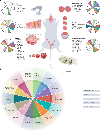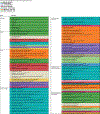Hallmarks of female reproductive aging in physiologic aging mice
- PMID: 39672896
- PMCID: PMC12139273
- DOI: 10.1038/s43587-024-00769-y
Hallmarks of female reproductive aging in physiologic aging mice
Abstract
The female reproductive axis is one of the first organ systems to age, which has consequences for fertility and overall health. Here, we provide a comprehensive overview of the biological process of female reproductive aging across reproductive organs, tissues and cells based on research with widely used physiologic aging mouse models, and describe the mechanisms that underpin these phenotypes. Overall, aging is associated with dysregulation of the hypothalamic-pituitary-ovarian axis, perturbations of the ovarian stroma, reduced egg quantity and quality, and altered uterine morphology and function that contributes to reduced capacity for fertilization and impaired embryo development. Ultimately, these age-related phenotypes contribute to altered pregnancy outcomes and adverse consequences in offspring. Conserved mechanisms of aging, as well as those unique to the reproductive system, underlie these phenotypes. The knowledge of such mechanisms will lead to development of therapeutics to extend female reproductive longevity and support endocrine function and overall health.
© 2024. Springer Nature America, Inc.
Conflict of interest statement
Competing interests: The authors declare no competing interests.
Figures


References
-
- Broekmans FJ, Soules MR & Fauser BC Ovarian aging: mechanisms and clinical consequences. Endocr. Rev. 30, 465–493 (2009). - PubMed
-
- Traub ML & Santoro N Reproductive aging and its consequences for general health. Ann. N. Y Acad. Sci. 1204, 179–187 (2010). - PubMed
-
- Gameiro CM, Romao F & Castelo-Branco C Menopause and aging: changes in the immune system–a review. Maturitas 67, 316–320 (2010). - PubMed
-
- Adashi EY & Gutman R Delayed childbearing as a growing, previously unrecognized contributor to the national plural birth excess. Obstet. Gynecol. 132, 999–1006 (2018). - PubMed
-
- Martinez GM & Daniels K Fertility of men and women aged 15–49 in the United States: National Survey of Family Growth, 2015–2019. Natl Health Stat. Report 1–22 (2023). - PubMed
Publication types
MeSH terms
Grants and funding
- R01 HD103384/HD/NICHD NIH HHS/United States
- R56 AG056046/AG/NIA NIH HHS/United States
- R01HD103384/U.S. Department of Health & Human Services | NIH | Eunice Kennedy Shriver National Institute of Child Health and Human Development (NICHD)
- R01HD105752/U.S. Department of Health & Human Services | NIH | Eunice Kennedy Shriver National Institute of Child Health and Human Development (NICHD)
- T32 HD094699/HD/NICHD NIH HHS/United States
- R01 HD105752/HD/NICHD NIH HHS/United States
- AG056046/U.S. Department of Health & Human Services | NIH | National Institute on Aging (U.S. National Institute on Aging)
- P01 AG029531/AG/NIA NIH HHS/United States
- AG029531/U.S. Department of Health & Human Services | NIH | National Institute on Aging (U.S. National Institute on Aging)
LinkOut - more resources
Full Text Sources
Medical

